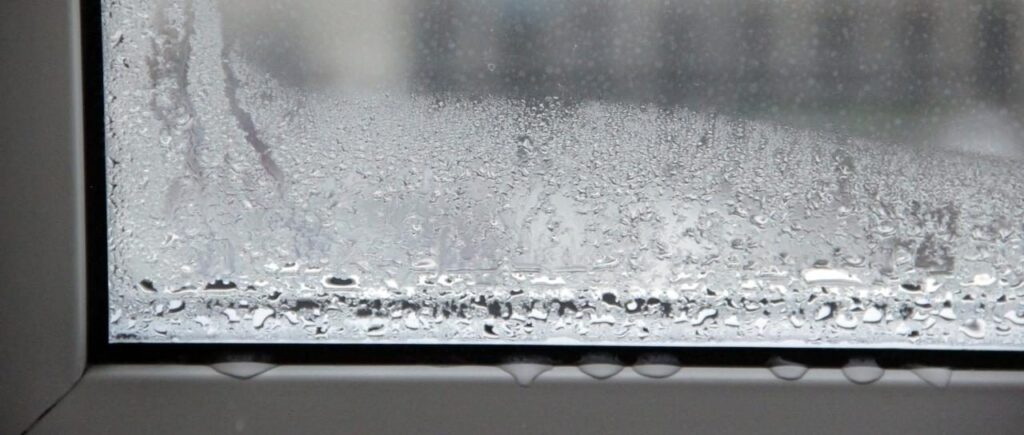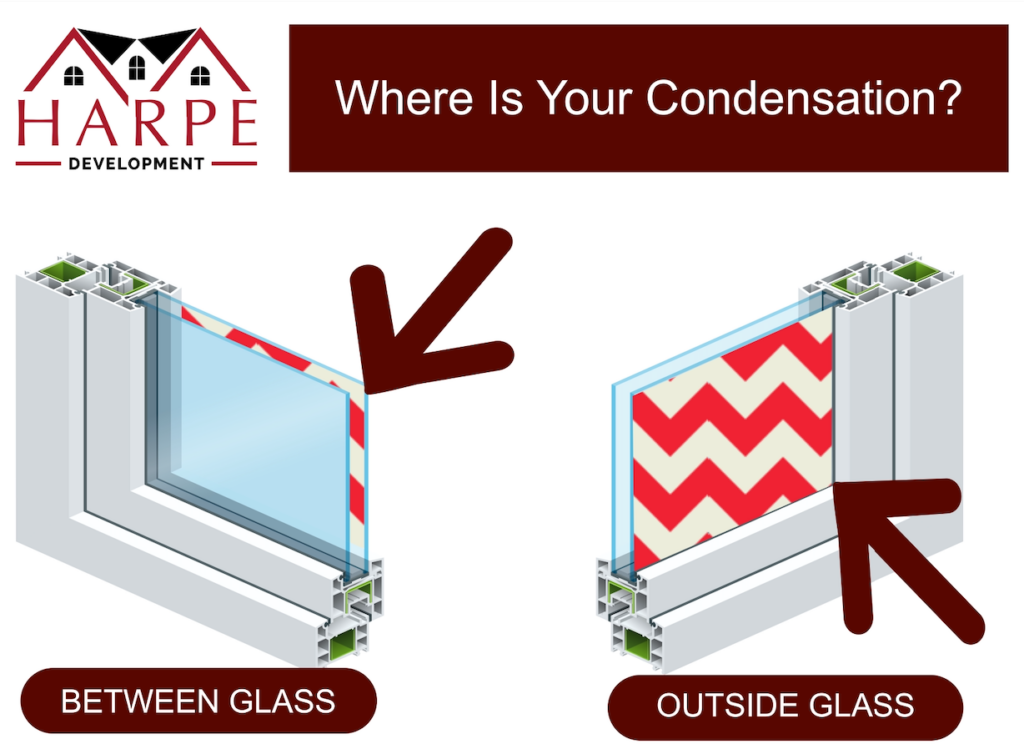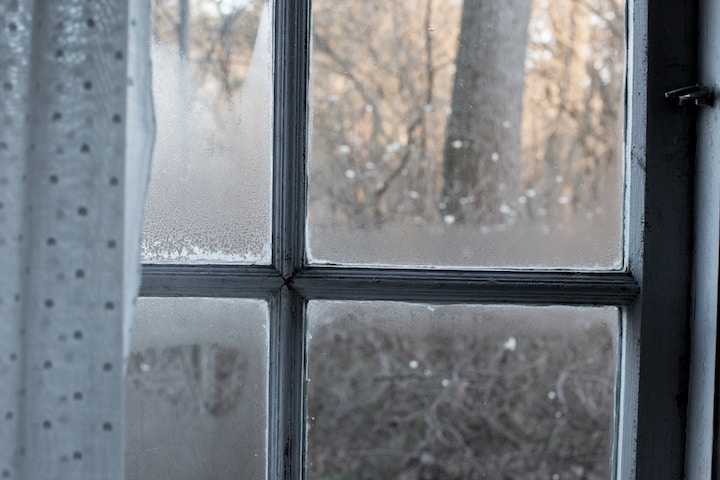WHAT CAUSES WINDOW CONDENSATION AND HOW TO FIX IT
Written By Dustin Harpe
Learn the reasons why condensation forms on windows and the potential consequences of moisture buildup due to window condensation.

Are you curious why your windows are fogging up? Window condensation is a confusing topic.
People generally have misconceptions about why it happens and what causes it. Even houses built to the highest professional standards can develop condensation on windows. It’s something that can happen regardless of your home construction or window quality, but thankfully, it isn’t always bad, and there are ways you can help stop it before it starts.
In this blog post, we’ll discuss the reasons why condensation forms on windows and the potential issues of moisture buildup due to window condensation. So put down that towel and keep reading – we have all the answers you need about window condensation.
WHAT IS CONDENSATION?
Condensation is a byproduct of the water cycle. It is the result of a vapor changing into a liquid and occurs when vapor cools to where it condenses into droplets or when the air holds too much water and needs to release some of the liquid.
WHY DOES CONDENSATION HAPPEN ON WINDOWS?
Condensation occurs because of three main factors that all help vapor change to water droplets—humidity, temperature and ventilation.
- Humidity – Within a home, humidity is a big cause. Everyday activities create a lot of moisture that sits in the air. Taking a warm shower and boiling water are two excellent examples.
- Temperature – Temperature is another factor. Any time the indoor and outdoor temperatures are at odds, it creates an ideal environment for condensation on windows.
- Ventilation – The final factor is ventilation. If air can move about, it helps to keep the humidity down. Through proper ventilation, it is possible to remove the humid air and replace it with drier air.
Condensation happens on windows because the window’s surface is relatively cool compared to the air temperature. When warm air hits the cool glass, it results in condensation. It’s most common in winter because windows stay cooler due to the cold temperatures outdoors and warm air inside.
With that being said, condensation on windows can happen at any time throughout the year. In the summer, you may cool your home and cause a similar situation to the winter but in reverse, with hot air outside and cool air indoors.
The temperature differences in windows happen regardless of how expensive or well-made they are because of their materials and design.
Regardless of where humidity originates, it can easily travel throughout your home. For example, if you have a hot, steamy shower, the humid air can travel through the porous materials in the walls and doors to travel to other rooms, leading to condensation on the windows.
Condensation is especially prevalent in newly built homes because of their energy efficiency. A well-built home will prevent air leakage from inside to out and vice versa, which is great when it comes to fuel and electric bills, but creates the perfect environment for window condensation.
IS IT A SIGN SOMETHING IS WRONG?
Condensation is not typically a problem. It’s normal and harmless in most situations. Every window will have moisture collection from time to time. It’s not a reflection of bad craftsmanship or construction mistakes.
In fact, newer energy-efficient windows will actually develop condensation more easily. It is a natural result of the superior ability of the window to insulate.
Frost, ice or condensation forming between window panes are issues you want to fix because they indicate a failure within the window components.
Other types of condensation might be problematic if you notice an ongoing issue or something that never seems to go away. In these situations, you may want to take steps to find a solution. Leaving the condensation can lead to mold, rot, and other problems due to the excessive moisture.

UNDERSTANDING THE LOCATION OF CONDENSATION ON WINDOWS
Taking a close look at where the condensation is forming on your windows can tell you a lot about why it is happening.
During cold winter months condensation can occur on the window glass on the interior of the home because the inside of your home has higher humidity than the outside. Homeowners can also see frost or even ice if the temperatures outside drop low enough.
The opposite occurs in summer when there is hot humid air outside and cool air conditioning running inside the home. This is why condensation forms on the window’s exterior glass.
This condensation on the outside of your windows is nothing to be concerned about. You can simply wipe away the moisture with a soft cloth or a towel.
However, if you see condensation between the pieces of insulated glass that are within the panes of a dual-pane or triple-pane window, you likely have a bigger problem on your hands.

This issue usually happens with older or damaged windows and is an indication that there is something wrong with a seal—thus allowing water to get into the window.
When a window seal is solid, it won’t allow the cold air to leak in.
When a seal fails, it allows the interior area to fill with outside air that may contain humidity—creating condensation. Consider this an indication of an issue you want to fix as soon as possible.
WHAT SHOULD I DO ABOUT WINDOW CONDENSATION?

If condensation is not a persistent issue that is threatening mold growth, window deterioration, or damage to structural components or finishes in your home, then there really isn’t cause for concern. However, if issues are occurring it is important to first get to the bottom of what the source of the issue is before determining a solution.
If condensation is appearing on windows in a newly built home, relax, this is perfectly normal for the first year or longer. This is due to higher-than-normal levels of water vapor present in the air, resulting from freshly installed materials finally settling into their surroundings. During this period, especially during the first initial heating season in the home, windows may seem foggy and wet on cold days until the air normalizes again.
If you are in a home you’ve lived in for a while, you will want to assess the windows to identify the cause of the condensation.
Look for any wear, breakage, or damage that could be allowing air leaks. If your windows appear in good shape or they are brand new, then your problem is likely with humidity levels or ventilation.
ADDRESSING HUMIDITY
To keep condensation at bay, achieving the perfect balance of humidity levels, temperature and air flow inside your home is key.
Humidity comes from water released into the air. This can happen in various areas within your home. The bathroom and kitchen are major sources, and the laundry room is another. Bathing and cooking release steam into the air. Drying clothing does the same.
If you have a room with a lot of plants, this could be an issue as well because plants will release moisture into the air. The same is true of an aquarium.
Your goal is to reduce the amount of water in the air. Some steps you can take to do this include:
- Moving plants and aquariums away from windows
- Turning off humidifiers or running them less frequently
- Install a vapor barrier if your home has a dirt floor crawlspace
- Do not store firewood inside
- Keep blinds and curtains open during the daytime
- Vent your dryer outside
- Use exhaust fans when bathing and cooking
- Dry clothing outside
- Put lids on boiling pans
It is helpful to stay on top of your home’s humidity level. You can begin by buying a hygrometer, which is a humidity sensor device. It will tell you the percentage of your home’s level. Ideally, you want to keep it between 30% and 50%.
That is just a guideline. You need to pay attention to clues telling you that the humidity is too high. If you see condensation, then you will want to lower the humidity.
Note the reading on your hygrometer when you see an issue and keep checking it to get an idea of where to keep the level. It will vary based on the time of year.
IMPROVING VENTILATION
Ventilation is the process of moving air. Proper ventilation will allow humid air to flow outside your home, which replaces it with drier air. You likely already use ventilation features in your home. The bathroom air vent or the exhaust fan on your stove are examples of these devices.
Another important aspect of ventilation is keeping air moving. Stagnant air will soak up water droplets and once it becomes too saturated, you get condensation. Ceiling fans are a great tool for moving air around and preventing that issue.
You should always use exhaust fans in the bathroom when showering to avoid a steam buildup. Also, use your stove top exhaust fan when cooking anything that produces steam.
Learn the proper ways to use ceiling fans for each season, as well. Most will have a switch that allows you to change the direction of the blade movement to complement either heat or air conditioning.
It is also advisable to do an audit of the ventilation in your home if you struggle with condensation on windows. Check out your dryer vent system. Make sure it has a good seal so the warm and humid air is not escaping as it travels through the hose.
Clean out exhaust fans. They can easily build up dust which makes them less effective. If you have a fireplace, check it for air leaks.
Also, consider your furniture arrangements. Placing items close to walls inhibits air circulation. Ideally, you want to allow space between the furniture and walls.
If you really struggle with humidity in your home, consider installing a whole-house ventilation system. This may be something worth discussing with your builder if you live in an area that experiences high humidity or if you know that your household already struggles with excess moisture issues.
NEW HOME BUILDING CONSIDERATIONS
If you are building a home and you know that condensation is an issue you have in your current place, speak to your builder about it. You can work together to create a design for your new house that will help reduce the chances of condensation issues. You can plan for habits or other factors in your household that may contribute to excess humidity, and you can enhance ventilation to stop issues before they start.
If you are already in the building process, you can still discuss your concerns with the builder. You may be able to add on items or make some changes during the finishing process to combat window condensation problems you feel may come up.
